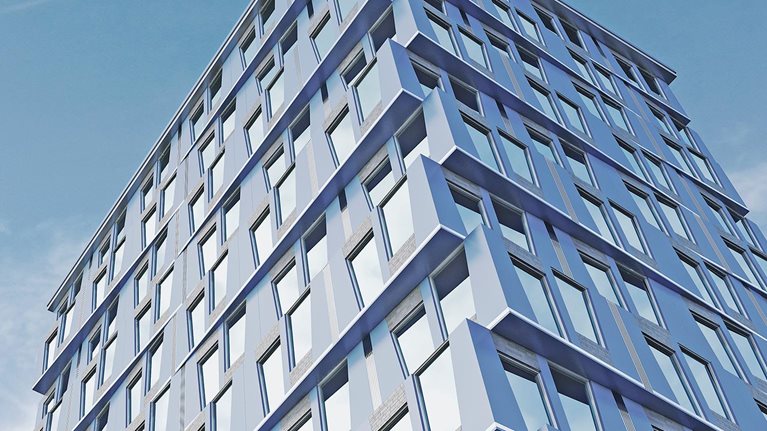The case for modular construction in the US is clear. Manufacturing building components in factories and assembling them on site offers solutions to many of the construction industry’s challenges, which include high material prices, disrupted supply chains, and shortages of skilled labor.
Industrialized production methods allow companies to optimize material utilization, reducing waste. Fitting modules together on site is quicker and requires less labor than traditional construction methods. McKinsey analysis suggests that modular techniques could allow home builders to accelerate end-to-end project timelines by 20 to 50 percent while reducing costs by up to 20 percent. Moreover, modular projects may be easier to execute on urban job sites since they require less space for the storage and preparation of materials.
Despite these apparent benefits, the approach has struggled to gain acceptance in North America. Less than 4 percent of current US housing stock was built using modular techniques, compared to 15 percent of homes in Japan, and 45 percent in Finland, Norway, and Sweden. Our analysis of recent historical growth projections for North American modular construction players paints a picture of only modest growth, despite these companies’ ambitious growth plans (Exhibit 1).

It doesn’t stack up
Why have modular players failed to persuade the US construction sector to adopt their offerings more widely? We believe that a big part of the challenge arises at the interfaces between modular companies and the wider construction ecosystem.
The benefits of modular buildings come from the industrialization of key construction tasks. Modular companies aim to standardize, streamline, and automate big parts of the value chain, allowing buildings to be treated like products rather than projects. To get that right, modular players need best-in-class manufacturing capabilities, including sophisticated digital design platforms and lean, efficient production lines.
As a result, modular construction companies often think of themselves first and foremost as design and technology companies. That difference is clear in the way these businesses present themselves to potential customers. The websites of modular players usually describe their production systems against a background of computer screens and computer-aided design (CAD) renderings. General contractors, by contrast, tend to lead on their track record in project execution.
Yet modular construction is still construction. Every modular building system needs a developer willing to buy it, a design able to accommodate it, a bank ready to finance it, and a skilled on-site team ready to install it. Each of these stakeholders needs to understand the requirements of modular systems. And, crucially, each needs to share in the benefits of the approach.
Modular construction players that ignore these vital ecosystem relationships can run into problems that erode their value proposition and even threaten the viability of their business. Let’s look at some common issues and how they might be addressed.
Would you like to learn more about our Operations Practice?
Overdesign
Standardization allows modular companies to use efficient series production techniques, but a design that is robust enough for every application will inevitably be over-engineered for most of them. For example, in multistory buildings, the loads experienced by upper-story units will be much lower than those at the base. Conventional building techniques therefore call for different specifications for different floors. Designs that use stacks of repeated modules, by contrast, tend to stick to a single specification optimized around the highest loads. That mismatch can inflate material costs and reduce the competitiveness of modular designs.
Companies can address overdesign by using design-to-value techniques to optimize features and material specifications for individual modules prior to manufacture, thereby minimizing excess use of steel, wood, and concrete. One player reduced its modules’ steel content by up to 30 percent during preproduction design reviews by having a skilled cost-engineering team design high-, medium-, and low-stress versions of the same product. Doing so reduced the company’s raw material costs while generating further reductions in manufacturing times, transportation requirements, and on-site assembly costs.
Inefficient installation
Because modular construction systems are still rare in the United States, few on-site contracting teams are familiar with them, potentially eroding the benefits of the modular system. For example, installation contractors who have made their careers in concrete-in-wood formwork may retain more schedule buffer than necessary on a modular project simply because of their lack of experience with the new components.
Because on-time, on-budget project execution wins in construction, leading modular companies are investing in their own project-management capabilities. They are hiring experienced construction industry professionals to work with contractors, oversee projects, and solve problems on the ground. And they are using those professionals’ knowledge and experience to continually refine their products, processes, and commercial approaches.
Inefficiency can also be self-inflicted, often in the name of higher overall margins. Modular systems can be an excellent fit for building designs that are repeatable and stackable, such as identical apartments or dormitories. But they have struggled with the types of bespoke designs that developers often prefer for high-end projects. They are also competing in a marketplace where multifamily residential customers increasingly look for some degree of customization. Rather than trying to make their standardized components fit in market niches that demand tailoring, leading modular players can remain disciplined, targeting projects with repeatability to minimize vertical times and maximize profitability. Or they can consider leaving finishing and customization of the finished product to developers and customers.
Insufficient capital
Modular construction is an especially capital-intensive approach in an already capital-intensive industry. Without a long track record of success, these systems are often seen as high-risk compared to traditional construction methods. This means modular firms must provide additional working capital for performance bonds to protect the building owner and “buy down the risk.”
Leading conventional construction firms understand that cash is king. They tend to excel at working-capital management, with strong procurement functions and robust management processes for change orders. Modular players need the same capabilities: getting paid like a construction company while acting like a technology company is not a promising long-term business model.
Yet the modular sector can also find ways to do things differently from their conventional counterparts. Some modular construction companies are already working with their finance partners to develop a phased bonding approach in which up to half of a project’s bond is released once the modules have been manufactured, with the remainder released at project completion.

Modular construction: From projects to products
Unsteady manufacturing pipelines
Production lines work best when demand is steady, and utilization is high. But, by nature, construction is a bumpy and variable industry. That mismatch creates a perennial headache for modular companies. The pursuit of work to fill idle production capacity has led some companies to enter low-value contracts, or to bid for projects in places where margins are consumed by high logistics and on-site labor costs.
To keep their factories busy with profitable work, modular players can adopt a smarter, more collaborative approach to business development. Some leading players are now using advanced analytics tools to give them a better understanding of construction costs in different regions. The cost per square foot of the same type of concrete construction can be as much as 28 percent higher in California compared to Texas, for example. When companies understand local market conditions well, they can focus their business development efforts on the most favorable regions for their product.
Leading modular construction players also work hard to develop long-term strategic relationships with designers, developers, general contractors, and major customers. We have seen modular firms increase their bid-win rate by as much as 15 percent when they have an existing partnership with the general contractor. A healthier pipeline of future work allows modular players to optimize their products and develop their production capabilities. That’s good for the sector as a whole as well: for offsite construction to become an industrialized alternative that can truly compete with traditional methods, strategic alignment between modular producers and at-scale developers may well prove critical.
The power of partnership
Working together on multiple projects brings significant benefits for all stakeholders. For example, collaborating with designers early on ensures building plans are appropriate for modular techniques. Our research also shows that, further downstream, repeat partnerships with general contractors are associated with higher, and significantly more consistent, project margins (Exhibit 2).

Modular players also face calls to share some of the financial returns of successful projects with their partners. As a senior executive at a large US construction firm told us recently: “General contractors have made this promise that [modular construction] is faster and higher quality, and also reduces costs. What we have seen is costs go down, but not for everyone. The benefit is not going to the actual owner of buildings, it is simply going to the supplier that provides the modular components.” Fully making good on their speed and cost promises may require modular firms to do more to ensure that the benefits hit the bottom lines of all players, including owners, construction installers, and end users. In an industry that historically has survived on thin margins, this flexibility may prove decisive in cementing long-term partnerships.
Everyone could win
For modular construction players, overcoming these challenges could unlock a new phase of accelerated growth. That would be good not only for the modular sector itself, but also for the rest of the construction industry—and for wider society frustrated by delayed, over-budget infrastructure projects.
To developers and general contractors, modular systems could bring faster project execution, higher margins, and greater competitiveness within cities and states that are increasingly environmentally conscious. Those same cities and states, meanwhile, could take advantage of modular techniques to produce more affordable housing on safer, smaller construction sites. And building that housing could provide good jobs for a wider skill base than conventional projects can accommodate.
With such big prizes at stake, the case for a transformation of the sector is difficult to overstate. The modular construction industry should rebuild itself, starting today.


